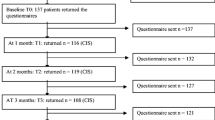Abstract
“Fatigue and malaise” (FM) is a frequent, non-specific symptom of cancer patients caused by the disease, its treatment and psychological distress. Since comprehensive quality of life assessment is often not feasible in multicentre clinical trials, short, but clinically relevant, quality of life indicators have to be defined. In a representative subsample of 127 patients in a phase-III randomized small-cell lung cancer trial comparing two different regimens of combination chemotherapy, quality of life was assessed at the beginning of each of the six treatment cycles with a self-rating questionnaire including an early version of the EORTC questionnaire, a mood adjective check list (Bf-S) and a single linear-analogue self-assessment scale (LASA) measuring general well-being. FM, measured with a five-item Likert subscale of the EORTC questionnaire, showed moderate to high intercorrelations with other EORTC subscales assessing disease symptoms, toxicity of treatment, role functioning, personal functioning, restriction of social activity, psychological distress, emotional (Bf-S) and general well-being (LASA). At baseline, FM was one of the most pronounced symptoms. Over the six cycles 43%–31% of the patients complained of moderate to severe fatigue. Over the first two cycles FM tended to decrease, slightly increasing during cycles 3 and 4 and decreasing again before cycle 6. In a multiple regression analysis over the six cycles, 53% of the variance of FM was explained by patient-rated symptoms of disease and toxicity (disease alone: 43%; toxicity alone: 35%). Initial performance status, previous weight loss, treatment arm, cycle number and age predicted the scores of FM over the six cycles. We conclude that, among other disease- and treatment-related scales, FM can be used as a global indicator of quality of life in small-cell lung cancer patients.
Similar content being viewed by others
References
Aaronson NK, Bullinger M, Ahmedzai S (1988) A modular approach to quality-of-life assessment in cancer clinical trials. Recent Results Cancer Res 111:231–249
Aaronson NK, Ahmedzai S, Bullinger M, Crabeels D, Estapé J, Filiberti A, Flechtner H, Frick U, Hürny C, Kaasa S, Klee M, Mastilica M, Osoba D, Pfausler B, Razavi D, Rofe PBC, Schraub S, Sullivan M, Takeda F, for the EORTC Study Group on Quality of Life (1991) The EORTC core quality of life questionnaire: interim results of an international field study. In: Osoba D (ed) Effect of cancer on quality of life. CRC Press, Boca Raton Boston Ann Arbor, pp 185–203
Adler R, Hemmeler W (1992) Anamnese und Körperuntersuchung, 3rd edn Fischer, Stuttgart Jena New York, pp 211–270
Bernhard J (1992) Lebensqualität in onkologischen Therapiestudien. Konzepte, Methodik und Anwendung am Beispiel des kleinzelligen Bronchuskarzinoms. Lang, Bern Frankfurt New York
Butow P, Coates A, Dunn S, Bernhard J, Hürny C (1991) On the receiving end. IV. Validation of quality of life indicators. Ann Oncol 2:597–603
Campell DT, Fiske DW (1959) Convergent and discriminant validation by the multitrait-multimethod matrix. Psychol Bull 56:81–105
Egli H, Bernhard J, Gunn-Sechehaye A, Guex P, Hürny C, Blaschegg-Honsalek I, Schärer U, Tomamichel M, für die Sektion Psycho-Onkologie der Schweizerischen Arbeitsgruppe für klinische Krebsforschung SAKK (1993) Lungenkrebs und Lebensqualität, eine qualitative Untersuchung der individuellen Wirklichkeit von Krebskranken, Onkologen und Psycho-Onkologen. Lang, Bern Frankfurt New York (in press)
Hürny C, Bernhard J, Gelber RD, Coates A, Castiglione M, Isley M, Dreher D, Peterson H, Goldhirsch A, Senn HJ, for the International Breast Cancer Study Group (1992) Quality of life measures for patients receiving adjuvant therapy for breast cancer: an international clinical trial. Eur J Cancer 28:118–124
Hürny C, Bernhard J, Joss R, Willems Y, Cavalli F, Kiser J, Brunner K, Favre S, Alberto P, Glaus A, Senn HJ, Schatzmann E, Ganz P, Metzger U, for the Swiss Group for Clinical Cancer Research SAKK (1992) Feasibility of quality of life assessments in a randomized phase III trial of small cell lung cancer — a lesson from the real world. Ann Oncol 3:825–831
Hürny C, Bernhard J, Bacchi M, Wegberg B van, Tomamichel M, Spek U, Coates A, Castiglione M, Goldhirsch A, Senn H-J, for the Swiss Group for Clinical Cancer Research (SAKK) and the International Breast Cancer Study Group (IBCSG) (1993) The Perceived Adjustment to Chronic Illness Scale (PACIS): a global indicator of coping for operable breast cancer patients in clinical trials. Support Care Cancer 1:200–208
Küchler T, Schwarz R, Flechtner H, Bernhard J, Hürny C (1991) Quality of life in oncology: report of the Psychooncology Study Group of the German Cancer Society and the Swiss Group for Epidemiologic and Clinical Cancer Research. Eur J Cancer 27:293–294
Zerssen D v (1986) Clinical self-rating scales (CSRS) of the Munich Psychiatric Information System (PSYCHIS München). In: Sartorius N, Ban TA (eds) Assessent of depression. Springer, Berlin Heidelberg New York, pp 270–303
Author information
Authors and Affiliations
Consortia
Rights and permissions
About this article
Cite this article
Hürny, C., Bernhard, J., Joss, R. et al. “Fatigue and malaise” as a quality-of-life indicator in small-cell lung cancer patients. Support Care Cancer 1, 316–320 (1993). https://doi.org/10.1007/BF00364969
Issue Date:
DOI: https://doi.org/10.1007/BF00364969



